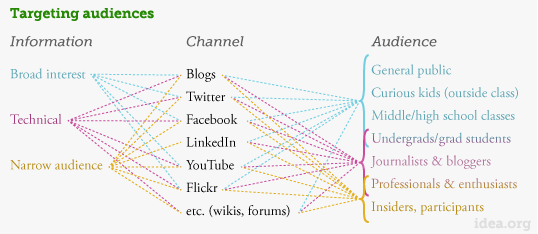Community Embraces New Word Game at Mid-Year Play Day This past Sunday, families at Takoma Park’s Seventh Annual Mid-Year Play Day had the opportunity to experience OtherWordly for the first time. Our educational language game drew curious children and parents to our table throughout the afternoon. Words in Space Several children gathered around our iPads […]
Read more Social media can feel like you are talking to the world, but in reality there’s a lot of self-selection going on. So know your audience.
Social media can feel like you are talking to the world, but in reality there’s a lot of self-selection going on. So know your audience.
Before the Internet, the gatekeepers of public information (journalists, editors and producers) considered the needs of audiences for you. These gatekeepers would filter a fire-hose of information in press releases and technical publications to deliver a digested slivers of information via television news, tv, print, and trade press. Other kinds of technical information was discussed at conferences, at meetings, in journals or in private. (See my post about “Fall of the gatekeepers“)
Who’s your audience?
A target audience can be defined by specific occupations (as in the diagram below), or can be stratified by age, educational levels, demographics, interests, roles/relationships, etc. Many people fall into multiple audience categories. The craft of social media lies in selecting and creating content for your audience. (See our post about the value of curating information on Twitter)
If you have multiple audiences, consider making more than one blog, or Twitter/Facebook account. Different kinds of information, earmarked for different target audiences, should be sent via the right channel:

For an example of this in practice, see the National Science Foundation’s Twitter accounts. NSF has a number of Twitter accounts (see list). The main account “@NSF” (107k followers) is administered by Dr. Paul Filmer, who writes some of the posts and chooses RSS feeds to automatically include. Other posts are written by 5-10 public affairs staff. The @NSF feed has a diverse audience, including the general public, students, and professionals.
The specialized accounts, e.g., @NSF_BIO, focus on program announcements and meetings. The kind of stuff Filmer says, “nobody but an academic would really be interested in.”
Filmer uses a mixture of manually-created posts, and automated posts, which creates it’s own challenges. Today the @NSF feed included a Tweet about a cool robotic fish (of interest to kids, the public, and robot enthusiasts) as well as a highly specialized Tweet: “Event: MPS Advisory Committee Meeting (MPSAC): Apr 7 2011 8:30AM toApr 8 2011 2:00PMRoom 1235Advisory Com…” an event which will have a total attendance of 30-40 committee members and NSF staffers — less than 0.02% of @NSF’s followers.
That’s the kind of Tweet Filmer tries to avoid. The event tweet originated from an RSS feed of events, and the number of event-related tweets recently spiked, drowning out the main feed. Filmer says he’ll have to kill the events RSS posts to keep the main @NSF feed interesting to a broad audience.

